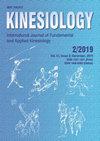Elbow joint position and hand pressure force sense under conditions of quick reaction in table tennis players
IF 0.9
4区 医学
Q4 REHABILITATION
引用次数: 4
Abstract
Joint position sense and force reproduction are the most commonly used measures of proprioception. It is interesting to measure proprioception in integration of the factors most commonly viewed as the most important in table tennis—speed, in particular quick reaction. The aim of this study was to evaluate the accuracy of replication of a specific range of motion and force of hand pressing under conditions of limited time. Forty table tennis players and 30 non-athletes participated in the study. Electrogoniometric and dynamometric methods were used in the investigation. The accuracy of replication of pronation and supination movements of the forearm at the elbow joint and force of hand pressing under conditions of limited time (performing the activity as fast as possible in response to visual signals) were measured. The tests performed in the study revealed that both female and male table tennis players were characterized by a higher level of forearm position sense during performing the fastest possible pronation and supination movements in most of the tasks. Better results of table tennis players than of the control group suggest that joint position and hand pressure sense integrated with quick reaction are important performance factors in table tennis. The results also indicate opportunities for using this methodology to monitor training.乒乓球运动员快速反应条件下肘关节位置及手压力感
关节位置感和力再现是本体感觉最常用的测量方法。将最常被认为是乒乓球运动中最重要的因素——速度,特别是快速反应——整合起来测量本体感觉是很有趣的。本研究的目的是评估在有限时间条件下复制特定运动范围和手压力的准确性。40名乒乓球运动员和30名非运动员参加了这项研究。研究中采用了电测法和测力法。测量了在有限时间条件下(根据视觉信号尽可能快地进行活动)肘关节前臂旋前和旋后动作复制的准确性和手按压力。研究中进行的测试显示,在大多数任务中,女性和男性乒乓球运动员在进行尽可能快的旋前和旋前运动时,都具有更高水平的前臂感觉。乒乓球运动员的成绩好于对照组,说明关节位置和手压感与快速反应相结合是乒乓球运动中重要的表现因素。结果还表明了使用这种方法来监测培训的机会。
本文章由计算机程序翻译,如有差异,请以英文原文为准。
求助全文
约1分钟内获得全文
求助全文
来源期刊

Kinesiology
REHABILITATION-SPORT SCIENCES
CiteScore
1.90
自引率
8.30%
发文量
16
审稿时长
>12 weeks
期刊介绍:
Kinesiology – International Journal of Fundamental and Applied Kinesiology (print ISSN 1331- 1441, online ISSN 1848-638X) publishes twice a year scientific papers and other written material from kinesiology (a scientific discipline which investigates art and science of human movement; in the meaning and scope close to the idiom “sport sciences”) and other adjacent human sciences focused on sport and exercise, primarily from anthropology (biological and cultural alike), medicine, sociology, psychology, natural sciences and mathematics applied to sport in its broadest sense, history, and others. Contributions of high scientific interest, including also results of theoretical analyses and their practical application in physical education, sport, physical recreation and kinesitherapy, are accepted for publication. The following sections define the scope of the journal: Sport and sports activities, Physical education, Recreation/leisure, Kinesiological anthropology, Training methods, Biology of sport and exercise, Sports medicine and physiology of sport, Biomechanics, History of sport and Book reviews with news.
 求助内容:
求助内容: 应助结果提醒方式:
应助结果提醒方式:


